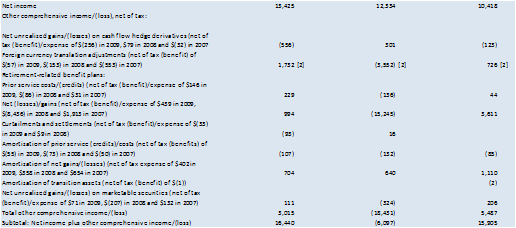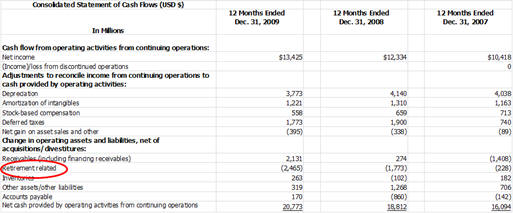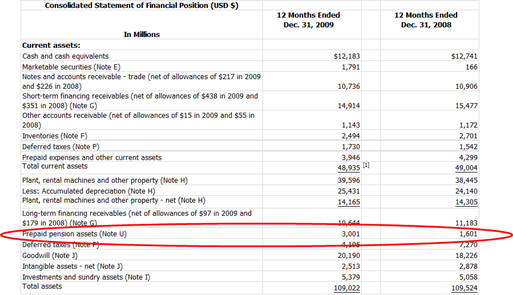7.14 Accrual Accounting Adjustments to Capital Expenditure
Under
US GAAP each firm must disclose certain items in their change to
Stockholders Equity section that may not flow through the
regular income statement.
These additional items flow in the concept of
“Comprehensive Income.”
Conceptual Note on Capital Expenditure:
In
dirty surplus accounting some items are adjusted to the
stockholder’s equity as opposed to the income statement.
The main three items are:
foreign currency translation, pension liability and hedge
accounting adjustments.
Of these three major items the pension liability
represents the cost of human capital component of capital
expenditure. This
item can fluctuate from year to year and so we will take the
average over the three years provided in the 10-K as a first
pass for “Other Comprehensive Income.”
For example for the case of IBM inspection of the
10-K reveals the following:

Looking at the last three years for the Retirement Related
Benefit Plan which is the sub component of Other Comprehensive
Income, it is evident that the year to year fluctuations are
large. As a result,
by taking the average:
Retirement Related Benefit Plan =
(229+994-93-107+704) +( -136-15245+16-132+640)
+(44+3611-85+1110-2)/3 = (2819) billion.
As a result, an additional adjustment is made to Capital
Expenditure to reflect the human capital and other components of
Capital Expenditure.
CAPEX
Payments for plant,
rental machines and other property (3,447)
Proceeds from
disposition of plant, rental machines and other property 330
Investment in software
(630)
Total CAPEX before Retirement benefit adjustments = 3,747
Adjusted Capital Expenditure = 3.747 + 2.819 = 6.566
billions
From the consolidated statement of earnings the weighted
average number of common shares outstanding for 2009 was
1,341,352,754 (assuming dilution).
FCFF per
share
= 12.381/1.341 = $9.233
Remark:
Note that in IBM’s Consolidated Cash Flow Statement from their 2010 10-K the following line item is present in relation to retirement benefits.

This
results from the fact that pension expense under GAAP is less
then IBM’s pension funding and so the corresponding entry is an
increase in the Prepaid Pension asset on IBM’s balance sheet
from 2008 to 2009:

So the
above adjustments have cash flow implications and are
appropriately accounted for in IBM’s financial statements.
So this leaves the question: what are “Retirement Related
Benefits” in Other Comprehensive Income?
Basically the answer to this arises from defined benefit
retirement plans.
Accounting for retirement
related Benefit Plans is based upon actuarial gains and losses
arising from current defined benefit plans.
This does not have cash flow implications but it does
have economic implications for assessing CAPEX and sustainable
FCFE because it represents a cost associated with human capital.
As a result, the treatment provided in the above example
was to average the amounts relating to retirement benefits in
Other Comprehensive Income across the three years resulting in
2.819 billon additional adjustment to CAPEX.
We next turn our attention to the
measure that is relevant for valuing a stock – this is FCFE.
